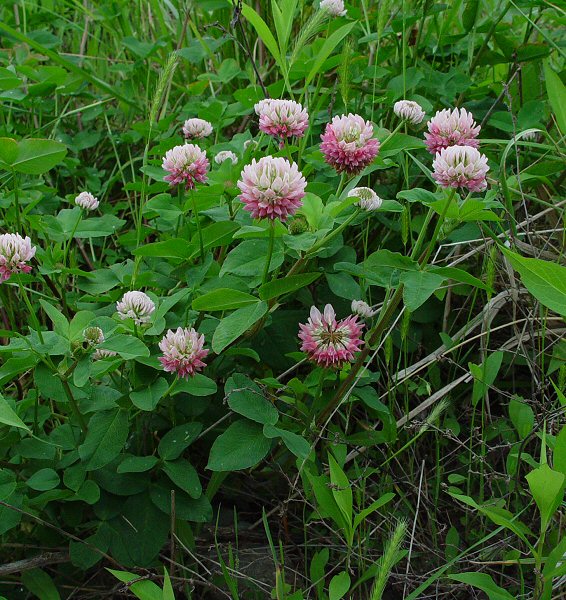Trifolium hybridum L.
Alsike Clover

Introduced
CC = *
CW = 3
MOC = 55
© DETenaglia
Trifolium hybridum L.Alsike Clover | |
 |
Introduced CC = * CW = 3 MOC = 55 |
© DETenaglia |
|
Family - Fabaceae/Faboideae Stems - Multiple from base, from taproot, ascending, to 50cm long, glabrous, tinted with red, herbaceous, sometimes fistulose.
Leaves - Alternate, petiolate, trifoliolate, stipulate. Stipules entire, glabrous, with reticulate venation throughout, to 2cm long, +5mm broad, acuminate. Petioles to 1cm long, glabrous, green. Leaflets subequal, on petiolules to 1mm long, glaucous below, dull green above, orbicular to broadly ovate, +/-2cm long, and broad. Margins denticulate to serrulate or stigillose from leaf venation extending beyond margin.
Inflorescence - Globose axillary pedunculate clusters of stalked flowers. Flowers +/-50 per cluster. Peduncles to -10cm long. Pedicels to +3mm long, pubescent, reflexed with maturity.
Flowers - Corolla papilionaceous, whitish at first - soon becoming pinkish - turning rose upon drying. Standard 4mm broad. Stamens diadelphous, connected for 2/3 of length. Style 2.5mm long. Ovary green, 2.2mm long. Calyx tube to 1.5mm long, 1.1mm in diameter, whitish, pubescent, 5-lobed. Lobes green, 1.2mm long, coarse pubescent. Fruit to +/-7mm long, glabrous, with +/-2 seeds.
Flowering - May - October. Habitat - Fields, pastures, waste ground, disturbed sites, roadsides, railroads. Origin - Native to Eurasia. Other info. - Yet another introduced member of the genus Trifolium. This plant is scattered throughout Missouri and grows in much of the U.S. and Canada. It was introduced as fodder and has subsequently spread. Our plants belong to var. pratense Rabenh. (synonymous with var. elegans (Savi) Asch. & Graebn.). Another variety, var. hybridum is larger and more commonly cultivated (mostly northward), but does not appear in our state, yet. Photographs taken off the MKT Trail, Columbia, MO., 5-12-04. |